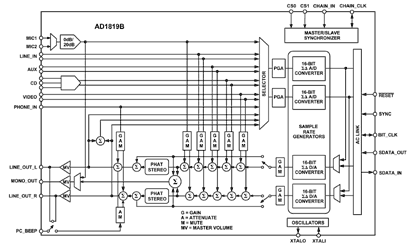AD1819BJSTZ-REEL: AC’97 SoundPort(R) Codec LQFP-48封装
The AD1819 offers superior price/performance for AC '97 motherboard and PCI card designs. The device includes Phat StereoTM 3D speaker enhancement and professional-quality, 92 dB signal-to-noise ratio - 4 times better than typical desktop configurations and 16 times better than today's portable PCs.
HOME THEATER CONFIGURATIONS
Daisy chain TDM mode supports up to three codecs on one ACLink bus for 5.1 speaker home theater designs
SIMPLIFIES DC '97 DESIGNS
Supports sample rates from 7kHz to 48kHz with 1Hz resolution On-chip hardware volume control
AD1819 IS THE MAINSTREAM CODEC OF CHOICE FOR:
- DC '97 audio solutions vendors developing 5.1 speaker, designs or wishing to simplify and cost reduce their controllers' sample-rate- conversion blocks
- PC system OEMs, VARs and integrators seeking to differentiate AC '97-compliant systems with professional-quality audio and Phat Stereo 3D speaker enhancement
- OEM motherboard and sound card manufacturers looking for the lowest-cost, highest quality AC '97 codec and designed - in interoperability with DC '97 controllers
TECHNOLOGY
Data Directed Scrambling: We use the term Data Directed Scrambling (D2S) to describe a new oversampling technology which delivers professional-quality audio to mass-market consumer appliances and multimedia PCs.
The AD1819 uses D2S to play .WAV, MIDI, AC-3. and PCM audio streams with better than 90dB signal-to-noise ratio. Using D2S the device is able to maintain a spectrally pure, "white" noise floor which is more pleasing to the human ear. D2 S also enhances the AD1819's immunity to noise sources on the PC motherboard and within the PC enclosure. Conventional sigma delta converters in PC sound codecs use 1-bit D/A converters (ie: switches), combined with gross oversampling and high-order noise shapers to achieve 80dB+ fidelity. One-bit structures offer inherent linearity, so they circumvent distortion or noise artifacts that would arise due to component mismatches in the D/A block. High-order modulators spectrally shape their quantization noise, placing it at frequencies beyond the auditory response of the human ear. After filtering, you get CD-quality, 16-bit performance from a 1-bit D/A.
One-bit designs have their drawbacks. First, the mathematics of high-order noise shapers give rise to spurious "idle tones" which are objectionable to the human ear. "Colored" noise sources can make a 16-bit sound codec sound worse than a device with lower SNR, yet dominated by a white noise floor. Secondly, 1-bit designs are sensitive to system noise or jitter on the master clock. Sampling precision in time determines the overall quality of the D/A conversion process.
Data Directed Scrambling uses multibit D/A structures instead of the conventional 1-bit technique to circumvent historical drawbacks of sigma delta designs. The D2S process actually shapes the spectral characteristics of noise and distortion caused by component mismatches in the D/A conversion process. Along with the quantization noise, these artifacts are pushed to frequencies beyond the auditory response of the human ear, then filtered.
The AD1819 uses a 4-bit D/A structure and D2S to enhance noise immunity on motherboards and in PC enclosures and suppress idle tones below the quantization noise floor of the device. The result is an audibly pleasing, professional-quality rendering of PC sound tracks from sources including DVD movies, Dolby Digital AC-3 tracks and studio-quality MIDI music synthesizers.
AD1819BJSTZ-REEL 特点
- Intel AC97 Compliance
- Full-duplex, 48kHz stereo I/O
- ACLink TDM serial interface
- Guaranteed interoperability with DC97- compliant controllersPower management modes
- Small-footprint, 48-pin TQFP package
- Microsoft PC 97 Compliance
- Supports all codec requirements for Entertainment PC class audio designs
- Independent record and playback sample rates 92 dB SNR playback and mixing
- Professional-quality, 3D Audio
- Data Directed ScramblingTM (D2S) technology delivers 92+ dB audio fidelity and freedom from spurious idle tones
- Continuous Time OversamplingTM technology for enhanced motherboard noise immunity Phat Stereo 3D speaker enhancement
AD1819BJSTZ-REEL 功能框图
AD1819B 芯片订购指南| 产品型号 | 产品状态 | 封装 | 引脚 | 温度范围 |
|---|---|---|---|---|
| AD1819BJST | 量产 | 48 ld LQFP | 48 | 商业 |
| AD1819BJST-REEL | 量产 | 48 ld LQFP | 48 | 商业 |
| AD1819BJSTZ | 量产 | 48 ld LQFP | 48 | 商业 |
| AD1819BJSTZ-REEL | 量产 | 48 ld LQFP | 48 | 商业 |
